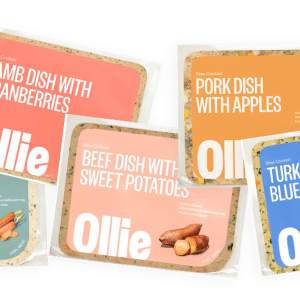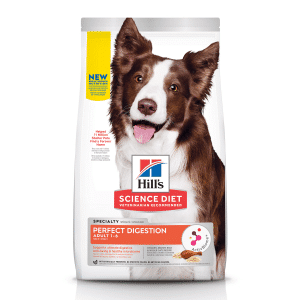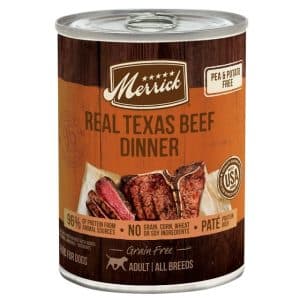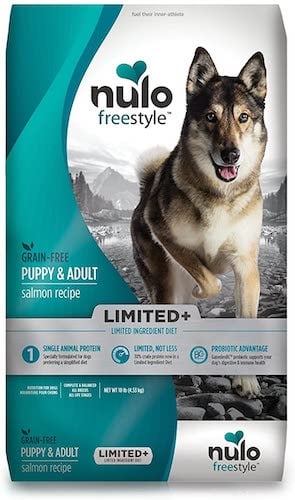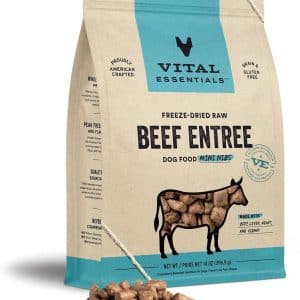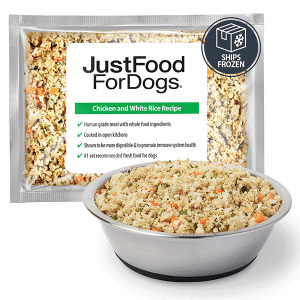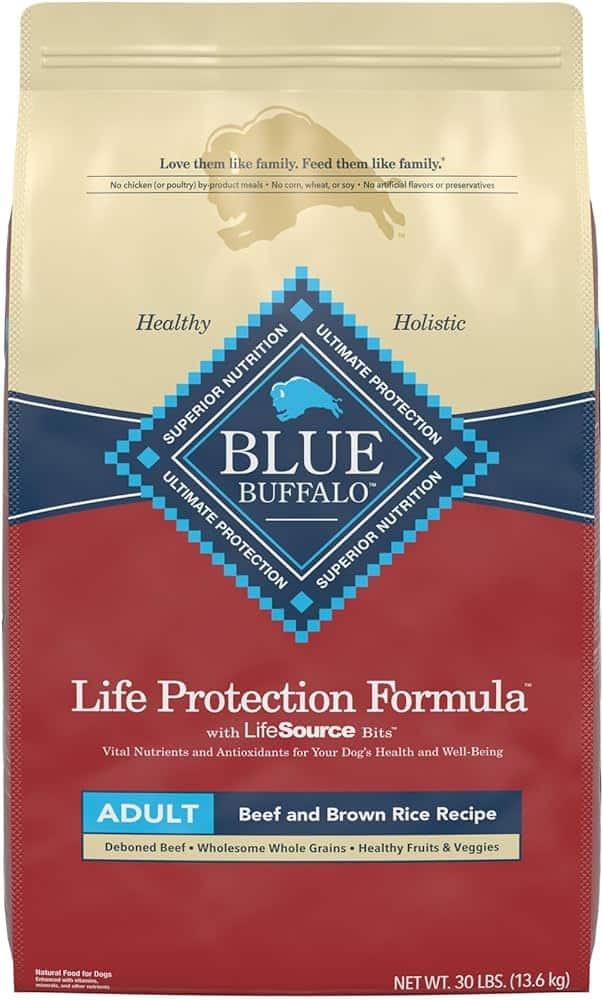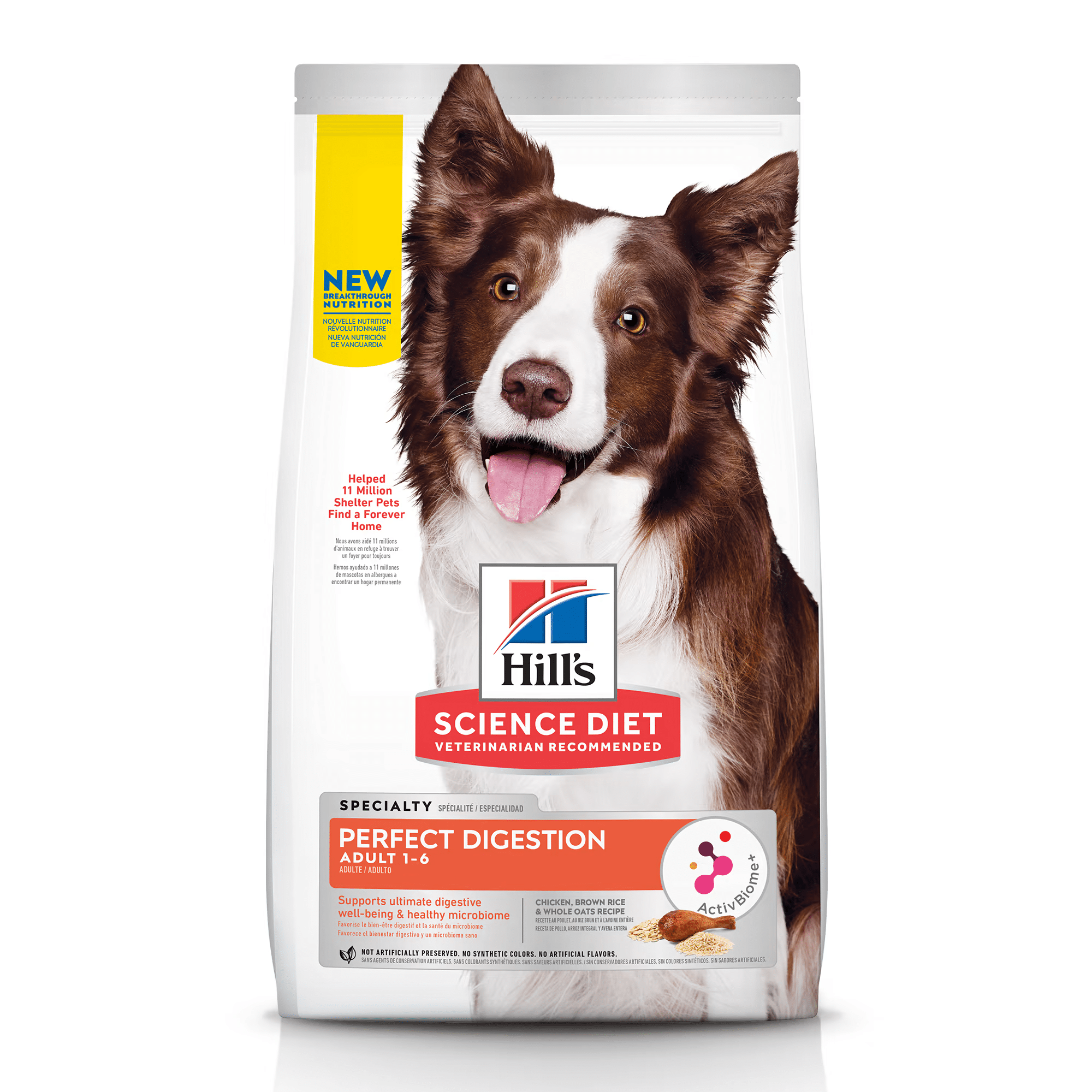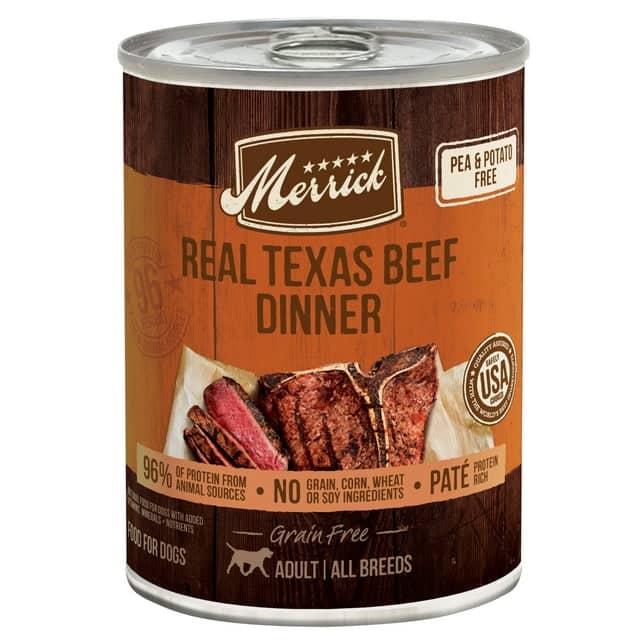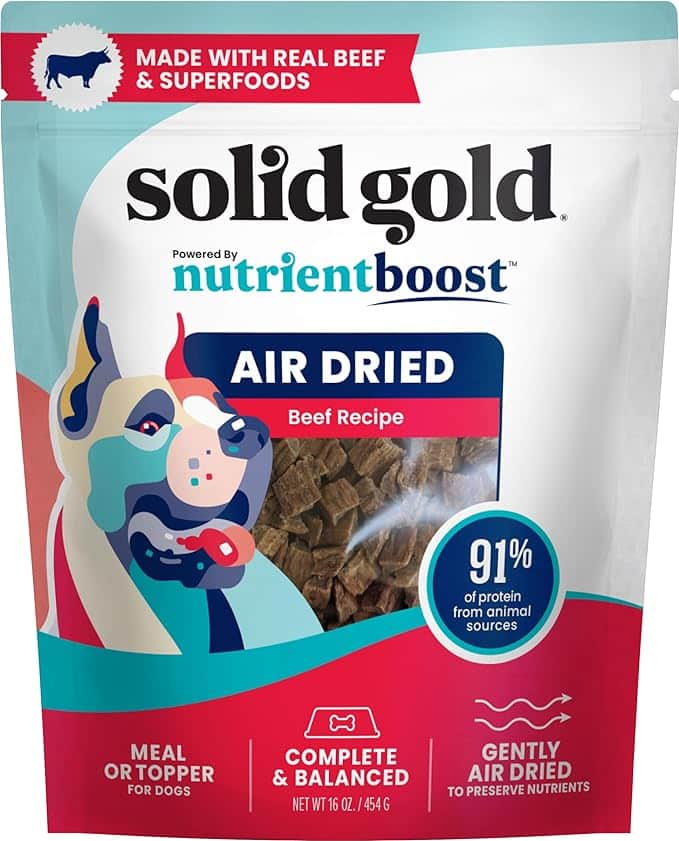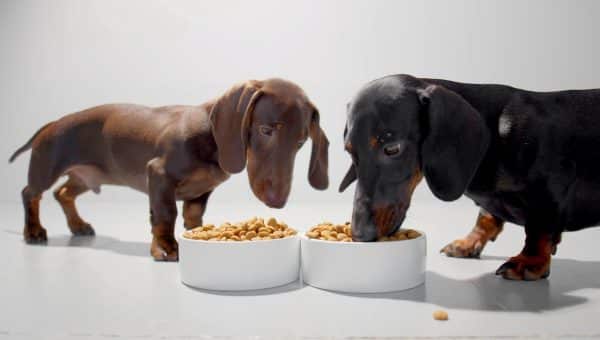- This review contains affiliate links. Read more here.
- Not a substitute for professional veterinary help.
Having a dog that’s a picky eater can be a real challenge. Some pups are so particular that it seems impossible to find a food they’ll eat. Because dogs can’t tell us exactly what they do and don’t like in their bowls, finding the best dog food for picky eaters can require a bit of trial and error.
There are various reasons why your dog might be finicky or even refuse to eat their food, from personal preferences to behavioral and medical concerns. The “best” food for your pup is one that they’ll actually eat—as long as it meets AAFCO guidelines and has your veterinarian’s sign off.
With that in mind, we’ve rounded up our top options for picky pups in a range of food types. Note that all listed nutrition details are calculated on a dry matter basis, which means that the percentages on the label are adjusted to account for the food’s moisture content. These calculations allow you to easily compare dry food, wet food, and everything in between.
Our picks
Best Dry Food for Picky Eaters: Blue Buffalo Life Protection Formula Beef and Brown Rice Recipe
Real beef, whole grains, and vegetables make up the first six ingredients in this dry dog food from Blue Buffalo. As part of the brand’s Life Protection Formula line, the recipe includes additional fruits and veggies, omega-3 and omega-6 fatty acids, and a blend of vitamins, minerals, and antioxidants to support your pup’s overall well-being.
Blue Buffalo’s Life Protection formula comes in several flavors, including beef, chicken, lamb, and fish, which reviewers give high marks for palatability. The beef recipe contains 26% protein and 15% fat—well within the recommended values for the average adult dog.
However, dogs with kidney and liver disease should be aware that the food contains 0.8% phosphorous, which may be higher than recommended for their needs.
Key Nutrients (for Beef & Brown Rice Recipe):
- 391 kcal/cup
- Protein: 26% min
- Fat: 15% min
- Crude Fiber: 6% max
- Calcium: 1% min
- Phosphorous: 0.8% min
- Omega-3 Fatty Acids: 0.6% min
- Omega-6 Fatty Acids: 2.2% min
- Glucosamine: 400 mg/kg
Best Subscription Dog Food for Picky Eaters: Ollie Fresh Dog Food (Verified Review)
Fresh dog food is a popular pick for fussy pups, and this subscription meal service offers a customized meal plan that makes it easier to find a good fit. The Ollie team asks questions to learn about your dog’s eating habits and dietary requirements. Their welcome booklet also includes tips for dogs with sensitive stomachs or picky eaters.
Ollie offers five different fresh recipes, each made with real meat (chicken, beef, turkey, pork, and lamb), vegetables, and fruits. Our reviewer described the portions as similar in form to human food, noting that the unique texture was appealing to some dogs who shy away from kibble.
Ollie’s recipes tend to be high in protein, ranging from 31% (chicken) to 38% (lamb) on a dry-matter basis. Fat content similarly ranges from 12% (chicken) to 27% (lamb). This puts all of Ollie’s fresh meals in the high-protein category, which may be appropriate for active and working breeds, as well as some overweight or senior pups. Even if your dog fits in one of these categories, you’ll want to confirm with your vet before switching to a high-protein formula.
Key Nutrients (Pork Dish with Apples):
- 1540 kcal ME/kg
- Protein: 32% min
- Fat: 25% min
- Fiber: 7% max
Pork, pork livers, butternut squash, rice, sweet potatoes, oats, peas, carrots, spinach, apples, tricalcium phosphate, salmon oil, salt, taurine, zinc gluconate, vitamin E supplement, ferrous sulphate, copper amino acid chelate, manganese amino acid chelate, cholecalciferol (vitamin D3) supplement, riboflavin (vitamin B2), thiamine hydrochloride (vitamin B1), pyridoxine hydrochloride (vitamin B6), potassium iodide.
Best for Sensitive Stomachs: Hill’s Science Diet Perfect Digestion Chicken, Brown Rice, & Whole Oats
If you suspect your dog’s picky eating has more to do with their tummy than their taste buds, you might consider a food specifically formulated to support digestive health, such as the Perfect Digestion Dry Dog Food from Hill’s Science Diet. This dog food is specially formulated to support your dog’s gut health, with prebiotics, pumpkin, and whole grain oats baked into the kibble formula.
The 22% protein and 12% fat content on a dry-matter basis are well within AAFCO’s standards, with a slightly higher-than-usual carbohydrate content thanks in part to high grain content that makes the food more digestible.
As an alternative, the Hill’s Science Diet Perfect Digestion Chicken, Vegetable, and Rice Stew is a lower-carb, canned alternative promising the same digestive benefits.
Key Nutrients:
- Calories: 369 kcal
- Protein: 22% min
- Fat: 12%
- Fiber: 4%
Chicken, Cracked Pearled Barley, Brown Rice, Brewers Rice, Whole Grain Oats, Whole Grain Corn, Corn Gluten Meal, Chicken Meal, Chicken Fat, Chicken Liver Flavor, Pork Flavor, Ground Pecan Shells, Soybean Oil, Lactic Acid, Potassium Chloride, Flaxseed, Dried Beet Pulp, Dried Citrus Pulp, Iodized Salt, Choline Chloride, Calcium Carbonate, Dicalcium Phosphate, Fish Oil, Pressed Cranberries, Pumpkin, vitamins (Vitamin E Supplement, L-Ascorbyl-2-Polyphosphate (source of Vitamin C), Niacin Supplement, Thiamine Mononitrate, Vitamin A Supplement, Calcium Pantothenate, Riboflavin Supplement, Biotin, Vitamin B12 Supplement, Pyridoxine Hydrochloride, Folic Acid, Vitamin D3 Supplement), minerals (Ferrous Sulfate, Zinc Oxide, Copper Sulfate, Manganous Oxide, Calcium Iodate, Sodium Selenite), Taurine, Mixed Tocopherols for freshness, Natural Flavors, Beta-Carotene.
Best Canned Food: Merrick Grain-Free Real Texas Beef Dinner Canned Dog Food
Beef is the primary ingredient in this high-protein canned food from Merrick. In fact, beef, beef liver, and beef broth make up the first three ingredients. There’s no grain, corn, wheat, soy, or chicken in the formula, making it safe for many dogs on a limited diet.
At 41% protein content on a dry matter basis, this canned food offers an especially high-protein recipe. Most dogs won’t need quite that much protein in their diet. Even active pups should confirm their diet with their vets. However, one of the benefits of canned food is its flexibility. The Real Texas Beef Dinner can be used as a standalone meal for dogs with high protein needs or in smaller amounts to complement dry food. Using wet food as a meal topper can make regular kibble much more enticing to a picky pup.
Key Nutrients:
- Calories: 393 kcal/13.2 oz can
- Protein: 41%
- Fat: 23% min
- Fiber: 6% max
Deboned Beef, Beef Liver, Beef Broth, Dried Egg Product, Natural Flavor, Salmon Oil, Salt, Locust Bean Gum, Potassium Chloride, Guar Gum, Calcium Carbonate, Minerals (Zinc Sulfate, Ferrous Sulfate, Copper Sulfate, Manganese Sulfate, Potassium Iodide, Sodium Selenite), Choline Chloride, Taurine, Vitamins (Vitamin E Supplement, Niacin, Thiamine Mononitrate, Calcium Pantothenate, Pyridoxine Hydrochloride, Vitamin B-12 Supplement, Riboflavin Supplement, Vitamin A Supplement, Folic Acid, Vitamin D-3 Supplement, Biotin)
Best Grain-Free Dog Food for Picky Eaters: Nulo Puppy & Adult Freestyle Limited Plus Grain-Free Dry Dog Food
With the complex recipes of most dog foods, it can be a challenge to determine exactly what makes your dog turn up their nose. An elimination diet is one of the best ways to sort through all of the possibilities, but how do you implement it when most dog foods contain similar ingredients?
The Nulo Freestyle Limited+ is formulated without common dog food ingredients (and allergens) like chicken, corn, wheat, soy, eggs, peas, and white potato—and without grains. It uses a single protein source (in this case, salmon) to minimize the likelihood of any intolerances. Probiotics in the recipe aim to ensure a healthy gut, while vitamins and minerals like DHA, calcium, vitamin E , omega-6 fatty acids, and omega-3 fatty acids help to support overall health at all ages.
At 1.2% phosphorous content on a dry matter basis, this food may be out of range for dogs with liver or kidney health concerns. And while it is marketed as appropriate for both puppies and adult dogs, the differing nutritional needs of pups in these stages mean that you’ll want to be thoughtful about how and how much you’re feeding your pup throughout their growth and life.
Key Nutrients:
- Calories: 438 kcal/cup
- Protein: 33% min
- Fat: 20% min
- Fiber: 6.1% max
- Docosahexaenoic Acid* (DHA): 8.9% min
- Calcium: 1.3% min
- Phosphorus: 1.2% min
- Vitamin E: 300 IU/kg min
- Omega-6 Fatty Acids: 3.7% min
- Omega-3 Fatty Acids: 2.8% min
- Ascorbic Acid (Vitamin C): 65 mg/kg min
- Bacillus coagulans: 80,000,000 CFU/lb min
Deboned Salmon, Salmon Meal, Chickpeas, Chickpea Flour, Canola Oil (preserved with Mixed Tocopherols & Citric Acid), Sweet Potatoes, Miscanthus Grass, Natural Flavor, Potassium Chloride, Salt, Calcium Carbonate, Dried Chicory Root, Choline Chloride, Vitamin E Supplement, Zinc Methionine, Zinc Sulfate, Iron Proteinate, L-Ascorbyl-2-Polyphosphate (source of Vitamin C), Niacin Supplement, Ferrous Sulfate, Copper Proteinate, Copper Sulfate, Vitamin A Supplement, Manganese Proteinate, Thiamine Mononitrate, Calcium Pantothenate, Riboflavin Supplement, Pyridoxine Hydrochloride, Manganous Oxide, Biotin, Dried Bacillus coagulans Fermentation Product, Vitamin B12 Supplement, Vitamin D3 Supplement, Folic Acid, Sodium Selenite, Calcium Iodate, Rosemary Extract
Best Air-Dried: Solid Gold Nutrient Boost Adult Dog Topper
Traditional dry kibble is made by combining all of the ingredients into a cooked dough. Air-dried food, on the other hand, is made through evaporation rather than cooking. Proponents of air-dried dog food say that it preserves the nutritional qualities of the ingredients while being safer than fresh or raw foods.
This Solid Gold Nutrient Boost Air Dried Dog Beef Recipe is a flexible food that can be used as a full meal or a topper. It’s made with real beef, with 91% of the included protein coming from animal sources. In addition, the ingredients list contains “superfoods” like sweet potatoes and kale for a balanced meal.
Coming in at a whopping 45% protein content on a dry matter basis, the Solid Gold Nutrient Boost is unquestionably the highest protein dry food on our list. For some dogs, that much protein might be too much of a good thing. However, using it as a meal topper can add interest to your dog’s bowl without overloading them on protein.
Key Nutrients:
- Calories: 329 kcal/cup
- Protein: 45% min
- Fat: 19% min
- Fiber: 7%
Beef Lung, Beef, Beef Liver, Vegetable Glycerin, Pea Flour, Animal Plasma, Pea Fiber, Dicalcium Phosphate, Calcium Carbonate, Fish Oil (Preserved with Mixed Tocopherols), Sweet Potatoes, Pumpkin, Vitamins (Vitamin E Supplement, Thiamine Mononitrate, Niacin Supplement, d-Calcium Pantothenate, Riboflavin Supplement, Biotin, Vitamin B12 Supplement, Vitamin A Supplement, Vitamin D3 Supplement, Calcium Iodate, Pyridoxine Hydrochloride, Folic Acid), Spray Dried Animal Blood Cells, Kale, Carrots, Minerals (Zinc Sulfate, Zinc Proteinate, lron Proteinate, Ferrous Sulfate, Copper Proteinate, Manganese Sulfate, Sodium Selenite, Manganese Proteinate, Copper Sulfate), Salt, Choline Chloride, Rosemary Extract
Best Freeze-Dried Raw Food: Vital Essentials Freeze-Dried Raw Beef Entree Mini Nibs Dog Food
Beef components make up the first seven ingredients of the Vital Essentials Freeze-Dried Raw Beef Entree, which is made without grains or gluten. For dogs with allergies or intolerances, a limited-ingredient recipe like the beef entree can offer relief from many common dog food allergens.
As with air drying, freeze-drying is sometimes believed to retain more of the nutritional value of the food, locking in natural vitamins and minerals as well as flavor. For this food, the ingredients are freeze-dried into small pellets that are particularly well-sized for smaller dogs.
The Vital Essentials Raw Beef Nibs are not only high-protein (39% on a dry-matter basis), but also high-fat (35% on a dry-matter basis). For canine athletes, active pups, and working dogs, this combination can be beneficial to effectively fuel their day-to-day activities. However, this may not be the best dog food for picky eaters who prefer to spend their days chilling on the sofa.
Key Nutrients:
- Calories: 272 kcal/cup
- Protein: 39% min
- Fat: 35% min
- Fiber: 9% max
Beef, Beef Heart, Beef Liver, Beef Lung, Beef Fat, Beef Stomach, Beef Kidney, Herring Oil, Mixed Tocopherols (Preservative), Vitamin E Supplement, Zinc Amino Acid Complex, Iron Amino Acid Complex, Copper Amino Acid Complex, Manganese Amino Acid Complex.
Best Meal Topper: Blue Buffalo Wilderness Trail Toppers Wild Cuts
Specifically intended as a supplement to dry kibble rather than a full meal, each packet of Blue Buffalo Wilderness Trail Toppers contains just 77-78 calories. However, they’re full of juicy chunks of protein (beef, chicken, duck or salmon) doused in a thick gravy to make mealtime more appetizing.
One serving of beef or chicken topper contains approximately 44% protein (on a dry matter basis), making it a high-protein addition to your dog’s bowl. When using meal toppers, it’s essential to adjust your dog’s dry food. Calculate their total caloric intake, protein, and other nutrient percentages based on their total consumption to ensure that the meal is balanced according to AAFCO guidelines.
Key Nutrients:
- Calories: 78 kcals/pouch (beef); 77 kcals/pouch (chicken)
- Protein: 44% min
- Fat: 14% min
- Fiber: 8% max
Beef, Chicken Broth, Water, Chicken Liver, Dried Egg Product, Potato Starch, Natural Flavor, Guar Gum, Sodium Phosphate, Salt, Sodium Carbonate.
Chicken, Chicken Broth, Water, Chicken Liver, Dried Egg Product, Potato Starch, Natural Flavor, Guar Gum, Sodium Phosphate, Salt, Sodium Carbonate.
Best Fresh Dog Food for Picky Eaters: JustFoodforDogs Human-Grade Fresh Dog Food (Verified Review)
Another fresh dog food to tempt your picky pup, JustFoodforDogs specializes in human-grade dog food. Each recipe is cooked from fresh ingredients, then frozen for safe shipping and storage. While JustFoodforDogs is on more expensive than many options, our Rover review team reported JustFoodForDogs sparked above-average excitement in test pups. Plus, it’s available both by subscription and from some of your typical pet retailers.
JustFoodForDogs fresh dog food comes in six different varieties: Beef and Russet Potato; Chicken and White Rice; Fish and Sweet Potato; Lamb and Brown Rice; Turkey and Whole Wheat Macaroni; and Venison and Squash. This range of flavor profiles and ingredients also means a wide range in nutritional profiles to suit a variety of needs. Some even include vitamins and minerals for all life stages.
JustFoodForDogs’ offerings range from high-protein and low-fat to more moderate quantities suitable for the average pup. The venison recipe includes 50% protein and 11% fat on a dry matter basis, while the chicken has just 29% protein and 11% fat on a dry matter basis. The beef, fish, lamb, and turkey all fall in the middle.
Key Nutrients:
- Calories: 43 kcal ME/oz
- Protein: 29% min
- Fat: 11% min
- Fiber: 4% max
Chicken, Rice, Spinach, Carrots, Apples, Chicken Gizzard, Chicken Liver, Fish Oil, Dicalcium Phosphate, Calcium Carbonate, Salt, Choline Bitartrate, Potassium Iodide, Zinc Amino Acid Chelate, Magnesium Amino Acid Chelate, Vitamin E Supplement, Ferrous Amino Acid Chelate, Copper Amino Acid Chelate, Cholecalciferol (source of Vitamin D3), d-Calcium Pantothenate, Riboflavin, Vitamin B12 Supplement.
Best for Puppies: Royal Canin Puppy Dry Food
Puppies have different nutritional needs than adult dogs. This popular puppy food from Royal Canin is specially formulated to not only meet the general nutritional needs of puppies but also address the variances between small and large breed puppies as well. It comes in both the dry kibble listed here and in a canned option featuring slices of wet food in gravy, with specific recipes for dogs from extra small to extra large.
The medium-breed formula contains 33% protein on a dry matter basis. This falls well within the protein requirements for the average puppy, who need more protein to support their growth than the average adult dog. Following AAFCO recommendations, the protein content drops to 31% in the formula for large-breed pups.
Key Nutrients (Medium Breed Recipe):
- Calories: 410 kcal ME/cup
- Protein: 33% min
- Fat: 20% min
- Fiber: 4% max
- Vitamin E: 357 IU/kg min
Chicken By-Product Meal, Chicken Fat, Brewers Rice, Corn, Wheat, Wheat Gluten, Dried Plain Beet Pulp, Natural Flavors, Brewers Rice Flour, Corn Gluten Meal, Monocalcium Phosphate, Vegetable Oil, Sodium Aluminosilicate, Pea Fiber, Potassium Chloride, Salt, Fish Oil, Taurine, Calcium Carbonate, Fructooligosaccharides, Hydrolyzed Yeast, Choline Chloride, Marine Microalgae Oil, Dl-Methionine, Vitamins[Dl-Alpha Tocopherol Acetate (Source Of Vitamin E), L-Ascorbyl-2-Polyphosphate (Source Of Vitamin C), Biotin, D-Calcium Pantothenate, Vitamin A Acetate, Niacin Supplement, Folic Acid, Pyridoxine Hydrochloride (Vitamin B6), Vitamin B12 Supplement, Thiamine Mononitrate (Vitamin B1), Vitamin D3 Supplement, Riboflavin Supplement], Trace Minerals[Zinc Proteinate, Zinc Oxide, Manganese Proteinate, Ferrous Sulfate, Manganous Oxide, Copper Sulfate, Sodium Selenite, Calcium Iodate, Copper Proteinate], Marigold Extract (Tagetes Erecta L.), Yucca Schidigera Extract, Carotene, Rosemary Extract, Preserved With Mixed Tocopherols And Citric Acid.
Best Dog Food for Picky Seniors: Blue Buffalo Blue Homestyle Recipe Senior Chicken Dinner with Garden Vegetables Wet Dog Food
Many dogs become pickier about their food as they age, whether because of new intolerances or changing preferences or because aging teeth make it harder to chew their once-loved kibble. Supplementing or replacing their diet with a well-balanced meal of canned food can help make mealtime enjoyable again.
As a note, the AAFCO only has one set of nutritional recommendations for adult dogs. While there are many senior dog foods available on the market, there are no formal guidelines for older pups’ nutrition. However, some senior dog foods offer higher protein and fat, partly to offset a loss of muscle mass. In addition to 34% protein content on a dry matter basis, this canned food from Blue Buffalo also includes glucosamine and chondroitin in its formula. These supplements support aging joints to help keep an older dog mobile.
Key Nutrients:
- Calories: 396 kcal/cup
- Protein: 34% min
- Fat: 20% min
- Fiber: 9% max
- Glucosamine: 190 mg/kg min
- Chondroitin: 150 mg/kg min
Chicken, Chicken Broth, Chicken Liver, Carrots, Peas, Brown Rice, Barley, Oatmeal, Sweet Potatoes, Guar Gum, Potassium Chloride, Carrageenan, Cassia Gum, Choline Chloride, Cranberries, Blueberries, Flaxseed (source of Omega 3 and 6 Fatty Acids), Salt, Glucosamine Hydrochloride, Chondroitin Sulfate, Zinc Amino Acid Chelate, Iron Amino Acid Chelate, Vitamin E Supplement, Copper Amino Acid Chelate, Manganese Amino Acid Chelate, Sodium Selenite, Thiamine Mononitrate (Vitamin B1), Cobalt Amino Acid Chelate, Niacin Supplement (Vitamin B3), Calcium Pantothenate (Vitamin B5), Vitamin A Supplement, Riboflavin Supplement (Vitamin B2), Biotin (Vitamin B7), Vitamin B12 Supplement, Potassium Iodide, Pyridoxine Hydrochloride (Vitamin B6), Vitamin D3 Supplement, Folic Acid (Vitamin B9)
The Best Dog Food for Picky Eaters is One Your Veterinarian Approves
We said it before, but we’ll say it again: a veterinarian is your absolute best resource for finding the right diet for a picky pup. A vet can help you spot underlying health issues that might be contributing to your pup’s fickle behavior—especially if it’s new—and make sure your dog gets the right foods to support their nutritional needs.
As you introduce new foods to your pup, be sure to do so slowly. Gradually swapping your dog’s current food for the new meal helps to ward off any digestive upset due to new foods and gives them time to adjust. Many pet parents with picky eaters will start with a small bag or even a sample of the food they want to try. This helps ensure that they don’t sink a lot of money into a bag of food their pup won’t touch.
How We Chose the Best Dog Food for Picky Eaters
The products featured here were selected based on a combination of our own hands-on testing, a comprehensive look at customer reviews across a wide variety of retail platforms, and interviews with veterinary experts. To find the best dog foods for picky eaters, we particularly considered widespread appeal (based on number of positive reviews) and nutritional value, to ensure your picky eaters are still getting high-quality meals. We’re also always guided by the experience of feeding our own picky pups.
Further Reading
For more information about specific varieties of dog food and treats, read on!


